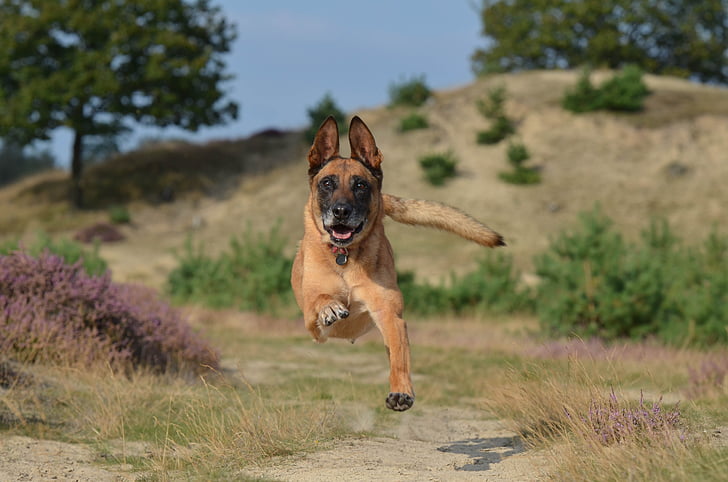The Belgian Malinois, a breed known for its remarkable intelligence and unwavering loyalty, stands as a paragon of canine excellence. Originating from Belgium, these dogs have been meticulously bred for their work ethic and versatility, excelling in various roles such as police work, search and rescue operations, and as loyal family companions. Their keen senses, agility, and trainable nature make them highly sought after for demanding tasks that require precision and reliability. With a rich history that underscores their contributions to society and the lives of their owners, the Belgian Malinois is more than just a pet; it’s a testament to the profound bond between humans and dogs, showcasing the limitless potential of this extraordinary breed.
Key Takeaways
- The Belgian Malinois is a highly energetic and intelligent breed, requiring regular exercise and mental stimulation to stay happy and healthy.
- Regular vet check-ups and a proper diet are crucial for maintaining the health of a Belgian Malinois, as they can be prone to specific health issues.
- Living with a Belgian Malinois means committing to active daily routines, including walks, runs, and training sessions to manage their high energy levels.
- When considering adding a Belgian Malinois to your family, seek reputable breeders or adoption agencies knowledgeable about the breed to ensure a healthy and well-socialized dog.
- Training and early socialization are key to managing the breed’s strong protective instincts and ensuring they are well-behaved family members.
- The Belgian Malinois thrives in environments where they can be part of the family’s daily activities, showcasing their loyalty and versatility in various roles.
Breed Overview
History
The Belgian Malinois, a robust and vigilant breed, has its roots deeply embedded in Belgium. They emerged in the late 1800s primarily as herding dogs, showcasing their agility and strength in managing livestock. The breed takes its name from Malines, a Belgian city that became pivotal in their development and breeding.
Over time, the Belgian Malinois transcended its initial role. By the early 20th century, they had gained international acclaim not just for herding but for their versatility in police and military roles. Their intelligence, coupled with a keen sense of duty, made them ideal for various tasks beyond the fields of Belgium.
Physical Characteristics
Belgian Malinois boast a medium-sized frame yet exude strength and athleticism. Their physical prowess is evident in their muscular build, designed for both speed and endurance. The breed’s short coat comes in shades ranging from fawn to mahogany, often accompanied by black markings that add to their striking appearance.
Distinctive features such as erect ears and a black mask not only define their look but also enhance their expressiveness. These characteristics are not just for aesthetics; they contribute to the dog’s sensory capabilities, crucial for their work in security and law enforcement roles.
Personality and Temperament
Known for their high intelligence and trainability, Belgian Malinois possess a remarkable work ethic. They thrive on challenge and purpose, making them excellent candidates for demanding jobs. However, it’s not all about work with these dogs; they are fiercely protective and loyal companions to their families.
Their temperament does come with a caveat: they can be wary of strangers, which makes early socialization critical. This wariness does not stem from aggression but rather from a deep-seated instinct to protect.
Belgian Malinois are bundles of energy that demand both physical exercise and mental stimulation. Without it, they can become bored and potentially destructive. It is this need for engagement that makes them less suited to sedentary lifestyles but perfect for active individuals or families who can match their vigor.

Health And Care
Common Health Issues
Belgian Malinois are generally healthy dogs. However, they can face some health challenges. Hip dysplasia and elbow dysplasia top the list. These conditions affect their mobility and can cause pain.
They may also suffer from genetic eye conditions. This includes cataracts and progressive retinal atrophy. Skin allergies are another concern, leading to discomfort and frequent vet visits.
Epilepsy is a risk for Belgian Malinois as well. It leads to seizures that vary in severity. Certain heart diseases pose a threat too, affecting their overall health and lifespan.
Dietary Needs
A high-protein diet fuels the Belgian Malinois’ active lifestyle. Their meals should be rich in nutrients to support energy levels and muscle maintenance.
Balanced meals are crucial. They need vitamins and minerals for joint health, especially given their risk of dysplasia. Foods with omega fatty acids help keep their skin healthy.
Portion control plays a key role in preventing obesity. Given their energetic nature, it’s easy to overfeed them without realizing it. Regular check-ups can help monitor their weight effectively.
Exercise Requirements
Belgian Malinois thrive on vigorous exercise. They need at least an hour of physical activity every day to stay fit and happy.
Their favorite activities include running, agility training, and playing fetch. These exercises keep them physically fit and mentally sharp.
Mental stimulation is just as important as physical exercise. Training exercises challenge their minds, keeping boredom at bay. This balance of mental and physical activity ensures a well-rounded routine for your dog.
Grooming
The coat of a Belgian Malinois is low-maintenance but still requires care. Regular brushing helps minimize shedding and keeps their coat healthy.
Occasional baths are necessary but should not be too frequent to avoid skin irritation. Using dog-specific shampoo protects their skin’s natural oils.
Regular ear cleaning prevents infections, while nail trimming keeps them comfortable on the move. Dental care is also essential for overall health, preventing gum disease and tooth loss.
Living with a Belgian Malinois
Training and Socialization
Early socialization is key for a Belgian Malinois. It helps them become well-adjusted adults. Without it, they might become shy or aggressive. These dogs are smart and pick up on things quickly. They do best with positive reinforcement and consistent training.
Training should start young. This breed excels in many dog sports. With the right approach, they can shine in obedience, tracking, and protection events. Their intelligence makes them eager learners but requires patience and dedication from their owners.
Environment
A Belgian Malinois needs space to run and play. A home with a spacious yard is ideal for them. Apartments don’t suit them due to their high energy levels. They could become restless in such confined spaces.
They thrive in an active family setting. Such families should be ready to meet their exercise demands daily. It’s not just about physical space but also about the commitment of the family to keep them engaged and active.
Activities They Enjoy
These dogs love being active and involved in various dog sports. Agility, flyball, and herding trials are among their favorites. These activities challenge their bodies and minds, keeping them happy.
Interactive games that test their intelligence also captivate them. They enjoy being part of family outings and outdoor adventures too. Their participation in these activities strengthens the bond between them and their families.

Breeder Advice and Adoption
Choosing a Breeder
When looking for a Belgian Malinois puppy, it’s crucial to find a reputable breeder. These breeders will have conducted thorough health screenings on the breeding dogs to ensure they are free of genetic diseases. This step is vital for the long-term health of your dog.
A good breeder won’t just sell you a puppy; they’ll provide comprehensive details about its health history and lineage. They understand the importance of transparency in this process. It’s not just about finding a pet but welcoming a new family member with confidence in its health and heritage.
Moreover, reputable breeders will encourage you to visit their facility. They allow potential owners to interact with the puppy’s parents and littermates. This interaction is essential. It gives insights into the puppy’s temperament, social behavior, and environment. Such visits can also reinforce your decision-making, ensuring the Belgian Malinois is the right fit for your home.
Adoption
Adoption offers an alternative path to bringing a Belgian Malinois into your life. Many rescue organizations specialize in this breed, providing homes for those in need. Adopting from these groups can give a second chance to dogs that have been lost, abandoned, or surrendered by their previous owners.
Choosing adoption means you’re not just getting a pet; you’re making a difference in that dog’s life. However, it’s crucial to ensure that the Belgian Malinois you adopt fits well with your lifestyle and living situation. Interaction before adoption is key here. Spend time with the dog to understand its temperament and needs.
Rescue organizations often know their dogs well and can help match you with one that suits your experience level and home environment. Remember, living with a Belgian Malinois requires commitment and understanding of their high energy levels and intelligence, as discussed earlier.
Misc.
Popular Names
Owners of Belgian Malinois often choose names like Max, Bella, Rex, and Luna. These names not only capture the essence of their pets but also reflect the dogs’ dynamic personalities and striking appearances.
Selecting a name that mirrors their personality or physical traits is common. For instance, a Malinois with a strong protective instinct might be named Guardian or Knight.
Short, easily recognizable names are preferable for training purposes. They make commands clearer and help in the dog’s faster response. Names with one or two syllables, such as Ace or Blaze, work best.
Fun Facts
The Belgian Malinois is frequently mistaken for a German Shepherd due to their similar looks. This confusion happens often, yet they are distinct breeds with different attributes.
They are known for their incredible sense of smell. This trait makes them perfect for search and rescue missions. Their ability to track scents over long distances has saved many lives.
Belgian Malinois have also been featured in movies and TV shows. This highlights their intelligence and versatility. Their roles in media demonstrate the breed’s adaptability and skill set beyond traditional canine tasks.
Top Dog Grooming Tools (Click Here)
Closing Thoughts
The Belgian Malinois emerges as a breed of remarkable versatility and resilience, suited for various roles from loyal companion to diligent working dog. Their care demands a committed owner ready to engage in rigorous training and provide ample exercise. Health considerations and living arrangements require thoughtful planning, ensuring these dogs lead fulfilling lives. Prospective owners should seek reputable breeders or consider adoption, keeping the breed’s welfare at heart.
This breed’s journey with their human counterparts underscores the importance of understanding and meeting their unique needs. For those considering a Belgian Malinois, it’s crucial to reflect on the commitment required to nurture their physical and mental well-being. Engaging with this breed offers profound rewards, fostering a deep bond between dog and owner. Readers are encouraged to further explore the world of Belgian Malinois, embracing the challenges and joys these extraordinary dogs bring.
Frequently Asked Questions
What is the lifespan of a Belgian Malinois?
The average lifespan of a Belgian Malinois is 14 to 16 years. This breed is known for its robust health and longevity, but regular veterinary care and a healthy lifestyle are essential.
How much exercise does a Belgian Malinois need?
A Belgian Malinois requires at least 60 minutes of vigorous exercise daily. This highly energetic breed thrives on physical activity and mental stimulation, making them ideal for active families or individuals.
What are common health issues in Belgian Malinois?
Common health issues in Belgian Malinois include hip dysplasia, elbow dysplasia, and progressive retinal atrophy. Regular check-ups with a veterinarian can help manage these conditions effectively.
Is the Belgian Malinois suitable for first-time dog owners?
No, the Belgian Malinois is not typically recommended for first-time dog owners due to their high energy levels and need for intensive training. They do best with experienced handlers who can provide firm, consistent guidance.
How do I find a reputable Belgian Malinois breeder?
To find a reputable breeder, look for those who perform health screenings on their breeding dogs, offer detailed medical history, and allow visits to see the puppies with their mother. Membership in breed clubs or recognition by national kennel clubs can also be indicators of quality breeding practices.
Can Belgian Malinois live in an apartment?
While it’s possible for a Belgian Malinois to live in an apartment, they require ample daily exercise and mental stimulation. Without sufficient activity, they may develop behavioral issues. A home with a yard or access to open spaces is preferable.
Are Belgian Malinois good with children?
Belgian Malinois can be good with children if raised together from puppyhood and if both the dog and children are taught how to interact properly with each other. Supervision is important to ensure safe interactions.






0 Comments